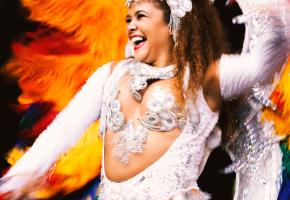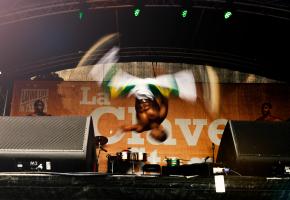All four artists have been resident in the Uk for some years, having studied at London Colleges and Bolivia. The Bolivian community here is not very large and they are hoping that other Bolivian artists will come forward as a result of this show and participate in future events. This is a show that is different and fresh. They were fortunate to find a suitable space in central London, right behind the Royal Academy. This was purely by chance:
Ivan Benítez, seen above: -
“We had developed the project and needed a gallery. We sent our proposal to many galleries and the estimates [for staging the show] were far too expensive for us and then it turned out that, by chance, Javier Molina, the photographer had done some work for the bookshop next door and noticed the space was not being used. When he enquired, it turned out it had been vacant for three years and was in a terrible state. There were no lighting connections, the walls were black and the floor spaces were littered with rubbish and debris. We had a huge job re-painting and cleaning. I became the electrician and connected all the spotlights and, from nothing, we created a proper Pop-up gallery! Now people are coming in to enquire about renting the space for other projects!
“Our objective with this Art Bolivia project is to show the work of Bolivian artists who have lived in the Uk for a long time. In my case, I have been here for over 20 years, Marcelo has resided here for 15 years, Fabiola for 10 and Javier for over 40 years. Our aim is to offer the public a new aspect of Latin American art to that which is seen in many exhibitions. This is a fusion of Latin American art with [Bolivian] people who lived here, who have absorbed local culture and become more contemporary. I studied art originally in La Paz, Bolivia, then I came to the UK to study at St Martin’s School of Art where the courses in mixed media really opened my eyes and mind to other possibilities both for my painting and sculpture. The interaction with Europeans that were more contemporary helped me apply new techniques to improve my work.”

Two years ago, Benítez had a solo show at the well-known Museo Tambo Quirquincho in the centre of La Paz. His symbolic work explores philosophical ideas on the human condition and the show was well received and Benítez was pleased that people commented that the work was very different to that normally seen in Bolivia and pointed out that it was challenging for art students to see it and experience art that was not traditional and to see how they could also explore different media and subject matter.
All four artists are very different in their work which is interesting to see.
Marcelo Rodríguez came to the UK in 2004 when Bolivia was in crisis and many believed it was on the brink of a civil war due to the mass protests demanding that the state nationalize their natural resources to avoid their being plundered by overseas interests and multi-nationals.
Known as the War of Gas (2003), the crisis, which started in 2002, was triggered by the exploitative trade deals to ‘give away’ the resources of natural gas to the USA and Mexico via Chile. The people demanded nothing should be exported until the internal energy market needs were solved. It led to the fall of power of the president and Rodríguez found, as did a large number of his compatriots, that he had to flee his country. 
Marcelo Rodríguez is a politically motivated individual. He comes from el Alto de La Paz, which, despite being at 4.061 metres above sea level, remains one of the most interesting and densely populated areas in the county. It grew exponentially after the now-ageing water pipeline was finally installed. The water issue remains ongoing and there is still the need for water tankers during dry seasons.
El Alto, surrounded by snow-capped mountains has remained a colourful area of individuality and character. Not least for its gender-neutral policy of using ‘cholitas’, Aymara women in their traditional multi- layered Andean skirts and brightly embroidered tops, as the area's’ ‘traffic cops’. Cholitas are strikingly original for also developing the ’Fighting Cholitas’ wrestling sport, as well as native fashion shows and beauty contests.

Colourful murals on apartment buildings in El Alto
From this background, Rodríguez admits to also being motivated and influenced by Evo Morales and his revolution, but resists returning because he feels that there is too much fake news everywhere about Morales and his policies: -
“I am married to a Lithuanian and we thought we’d like to go to back to Bolivia, especially now that the economic situation there has improved so greatly to what it was when I had to leave. Now there is a good government. I wanted to participate in the revolutionary movement but when I went there I realized that everyone there is already involved and there is a greater need to have Bolivians outside of the country defending Morales, because they go about saying he’s a dictator and there are too few Bolivians here to say”Listen Sir, you must be reading the Guardian or listening to the BBC, now, let me tell you the truth.”
In terms of his art, Rodríguez stresses that coming to the UK gave him the opportunity to dedicate himself to his work, in a proper studio, with a tutor, surrounded by people who were also producing works of art. He recognizes that working in an artistic environment has been a huge inspiration: -
“But there is the negative aspect in that there is the debate about art, versus, for example folk art. It’s a problem that people see our art as something artisanal, a craft. I don’t agree with those labels at all. When the Spanish came, they regarded the indigenous population as an inferior race, that everything we produced was inferior and since then, it’s been difficult to establish that our works of art are also valid, like Europeans, even Michelangelo or the Greeks. We have our own Tiahuanaco monuments… it’s not right that people say we don’t have our own art. The problem here, is that that the colonization confused the issues. Now we are experiencing a renaissance, and we’re managing to recover our culture, our languages and our art… that has nothing to do with the art that was imposed upon us.”
Despite his political inclinations, and the fact that he would like to reflect some of those ideas in his art, Rodríguez’ art is in fact deeply personal, individual and intuitive: -
“The problem is that most of my paintings are produced in an almost surrealist manner. I tend to approach art in a more unconscious, even dreamlike way … in terms of my use of colour, for instance. I grew up in the markets, immersed in the carnivals and the textiles. So, when I started to paint here and they asked me why I used so much colour, I told them that the colours are in my blood… what I most love about art is the absolute liberty it provides.”
 Javier Molina
Javier Molina
Similarly, colour is very significant in the works of the two photographers in the show Javier Molina and Fabiola Retamozo. Javier Molina, who studied at the New York School of Photography, works with many photographic images, up to 20 in one image, manipulating and combining them to create a mystical effect that is closer to a painting. He alters textures and colours according to what he wants to create.
Fabiola Retamozo has created paintings, installations and collaborative art. Here, some of her work has a clearer photographic style. There are also handmade materials and a poetic outlook, so that the images are very powerful, exploring isolation and detachment, largely due to unemployment and rejection. Rather than manipulating the images, she carefully prepares the tableaux according to the ideas that she wants to express.

“ANALOGUE INTERCOURSE” The First exhibition of contemporary Bolivian Artists in the UK was organized by the Henry Sotheran Ltd Building: -

















